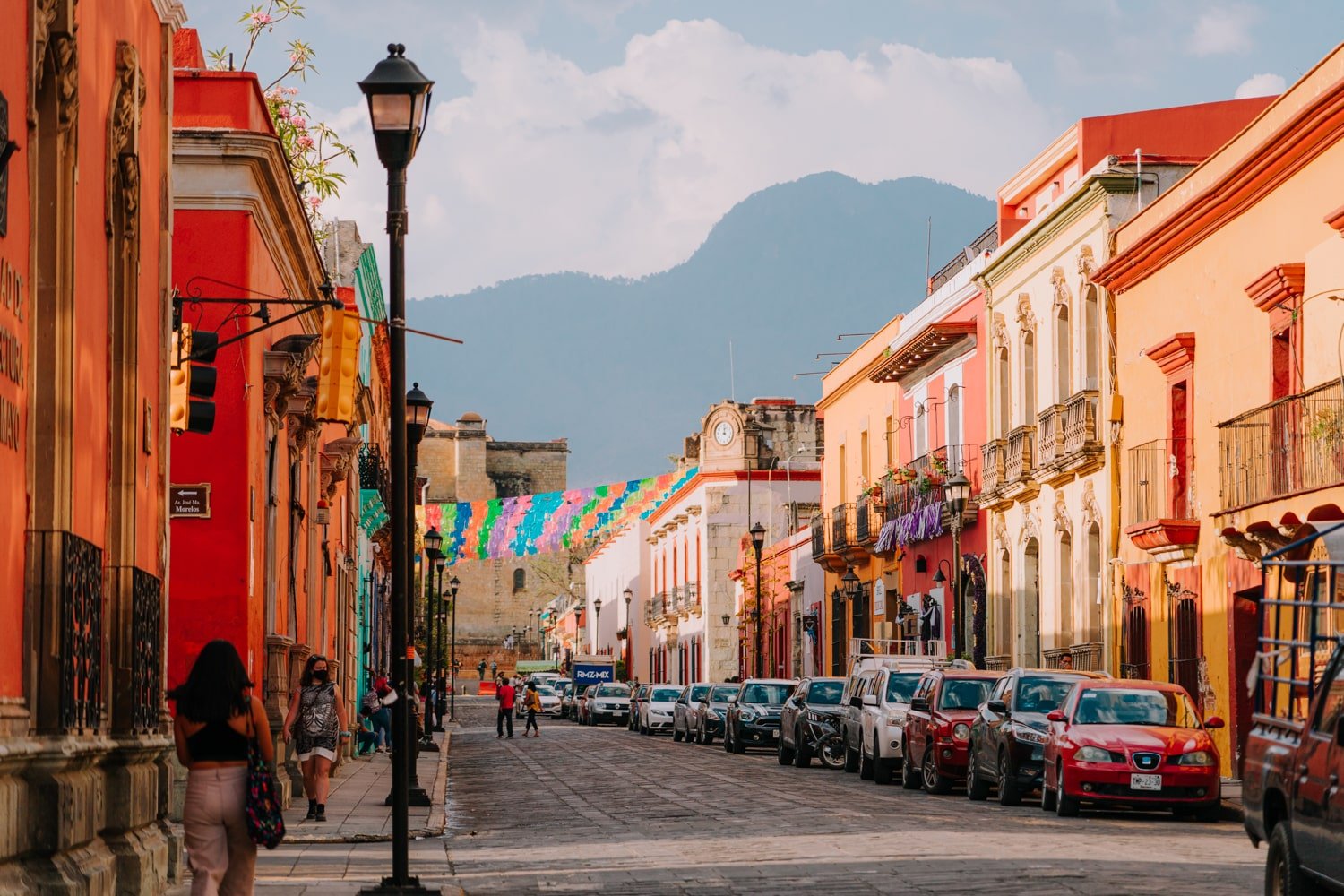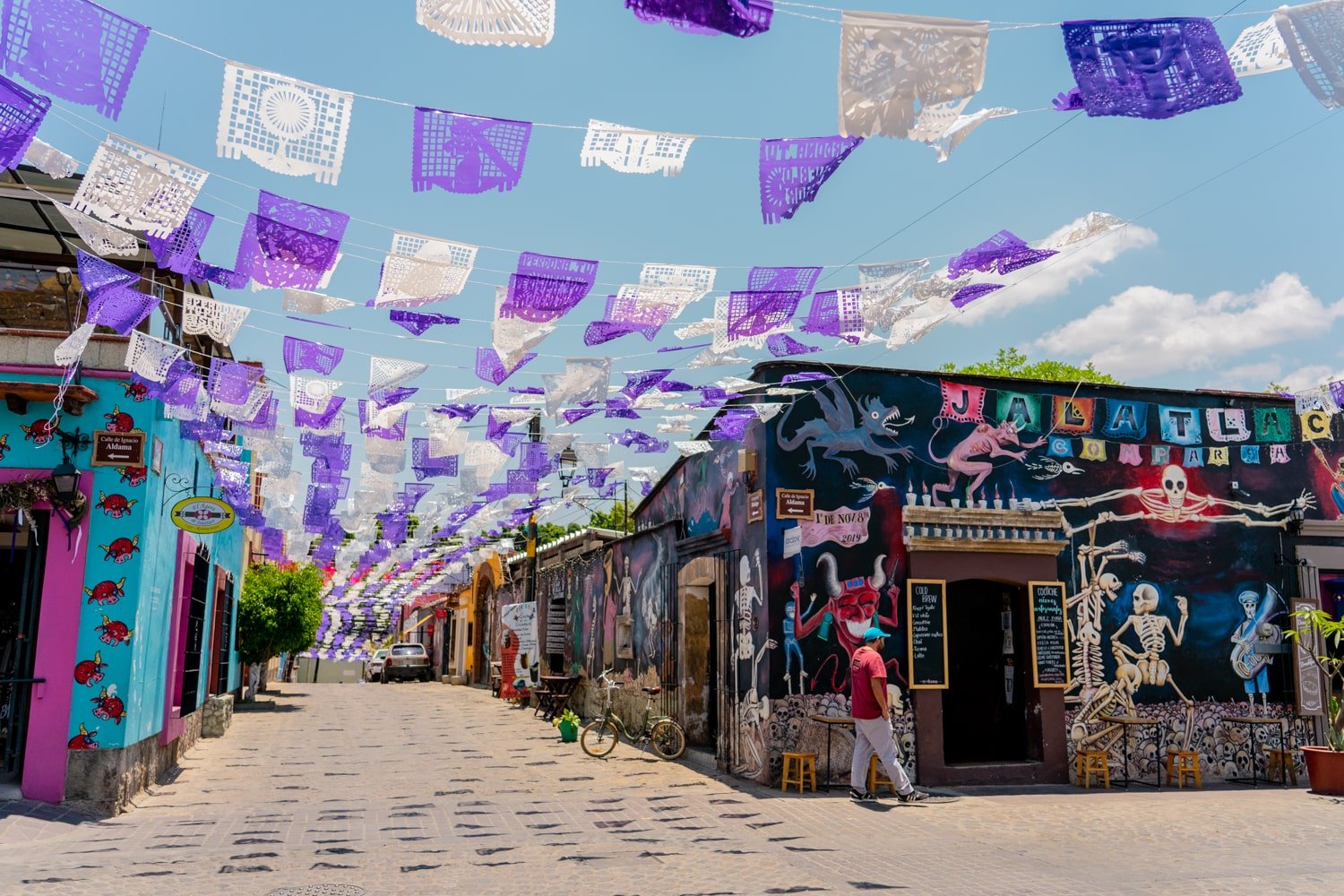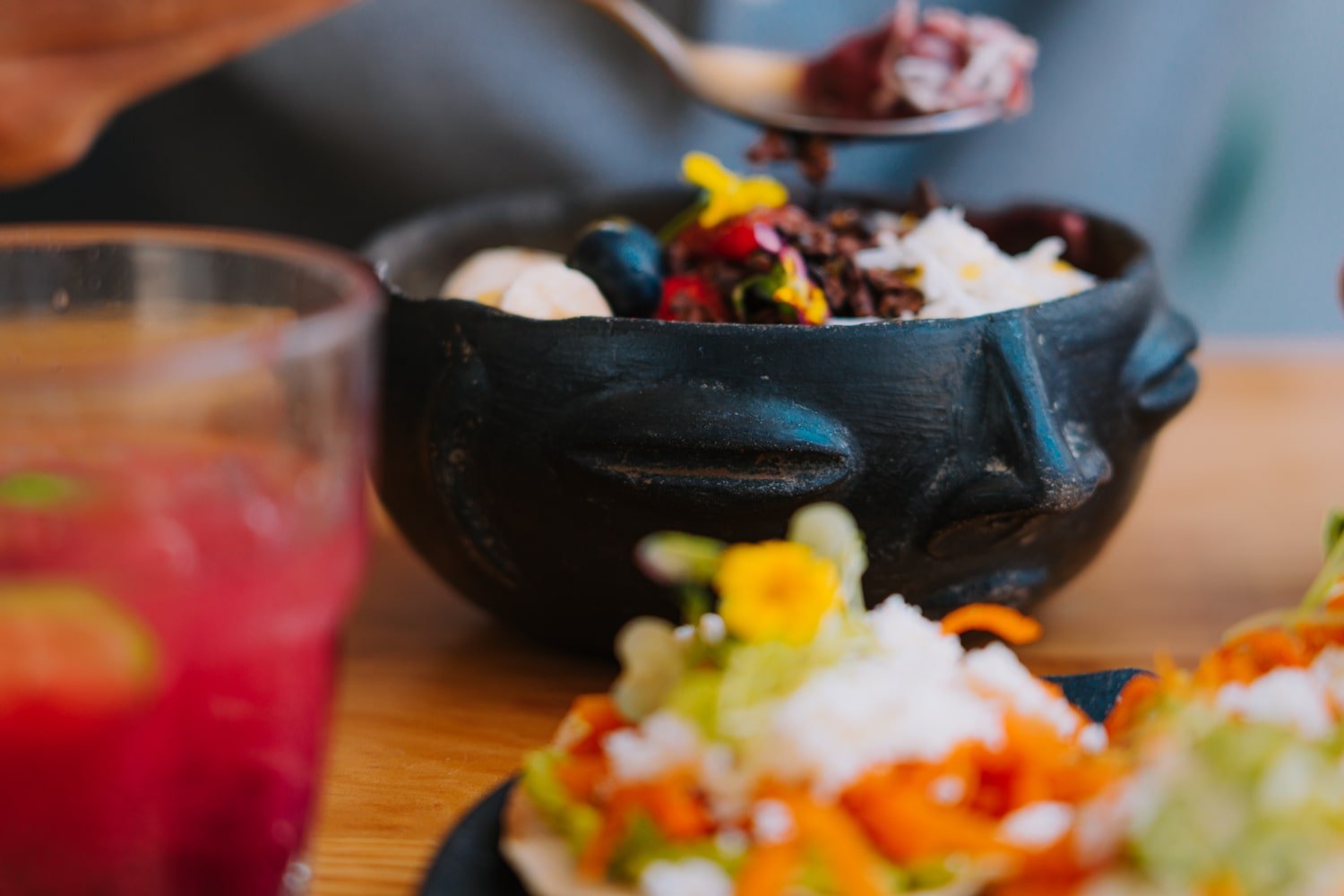How to Spend 4–5 Days in Oaxaca City: The Ultimate Itinerary
Disclosure: This blog is reader-supported, and some posts contain affiliate links. If you make a booking, I may earn a small commission—at no extra cost to you. Thank you for keeping me writing and doing what I love!
Oaxaca City (Oaxaca de Juárez) is arguably one of the best places to visit in Mexico, and in this 4-day or 5-day itinerary, I’m going to show you exactly why!
From its diverse indigenous cultures to its world-famous gastronomy to its sprawling, colorful markets, Oaxaca City offers plenty to discover, love, and experience in just a few days!


That said, while there are dozens of wonderful things to do in Oaxaca City, there’s only so much you can fit into an itinerary.
Luckily, spending four or five days just in Oaxaca City gives you ample opportunity to experience authentic Oaxaca, indulge in its cuisine and spirits, and wander off the beaten path.
After spending two months as a nomad in Oaxaca, I’ve curated this guide so that you can experience the best that the city has to offer.
So, if you’re ready to responsibly immerse in Oaxaca’s colorful maze of history, food, and more, read on!
Here is the ultimate Oaxaca City itinerary!
The Ultimate Oaxaca City Itinerary
Day 1: Oaxaca City’s Historic Center

On your first day in Oaxaca, you have to explore the historic city center (known as downtown Oaxaca or simply Centro).
After all, the historic center of Oaxaca City is a World Heritage Site, and as you stroll around, you’ll quickly see why.
Apart from the 1200+ registered historic sites in the area, you’ll be enchanted by Oaxaca’s colorful, low-lying buildings—many of which are built with green volcanic stone—designed to withstand earthquakes.

Beyond the architecture and the city’s iconic grid pattern (typical of Spanish colonial city planning), you will find hidden squares, hole-in-the-wall eateries, textile and boutique shops, quaint cafes, and much, much more.
✨ To make the most of your first day in the city, below are several must-see attractions and points of interest. By the way, my suggested sightseeing itinerary for day one is easily doable on foot and makes the perfect DIY walking tour of Oaxaca City!


Zócalo (Plaza de la Constitución)
At the heart of Oaxaca’s Centro Histórico lies the bustling Zócalo, or main square.
The Zócalo is a great starting point in any Oaxaca itinerary because it is constantly abuzz with activity.
The large, shady square is lined with shops, fine hotels, restaurants with outdoor patios, street vendors selling food and toys, men shining shoes, artists playing music, women selling textiles and crafts, and more.


At its center stands the Quiosco de Oaxaca inside the Jardín de la Constitución, a beautiful gazebo-like structure that often is the centerpiece for concerts or even protests (as was the case when we were there).
From here, waltz to the northwest corner of the square to find an adjacent plaza—the Alameda de León—on which stands the regal The Cathedral of Our Lady of the Assumption (Catedral Metropolitana de Oaxaca) dating back to 1535. It’s worth taking a peek inside!
Also, if you particularly enjoy art, then cross the street to quickly visit the Museo de Los Pintores Oaxaqueños (Museum of Oaxacan Painters) set inside a beautiful and historic 17th-century building. The entrance costs just $20 MXN pesos.
Alternatively, if you are into Oaxacan textiles and traditional clothing, the gorgeous Museo Textil de Oaxaca is just two blocks to the right of the Zócalo (plus, admission is free).
After you are done exploring the Zócalo and its surrounds, walk one block to your right (as if you were going behind the cathedral) and then bank left to continue north down the colorful, flag-strewn historic pedestrian-only street called Calle Macedonio Alcalá (or more commonly known as the Anador Túristico).
Tip: If you need to, you can squish this itinerary in case you end up spending only 2 days in Oaxaca or 3 days in Oaxaca.


Anador Túristico
As hinted by its name, this lane is quite a tourist destination. But fear not, it’s not a tourist trap per se.
The street is beautiful and iconic for a reason!
Car-free, you are able to stroll between the shops and restaurants with ease while visiting the nooks and crannies of the street.
We would always take this street to get to Cafe Brújúla—one of our favorite cafes in Oaxaca for its ambiance and chill inner courtyard—and the cute library called Librería Grañen Porrua.
This street continues for four blocks until it opens out to the even more regal Templo de Santo Domingo de Guzmán, an icon of Oaxaca City.



Between the two squares—the Zócalo and Santo Domingo—lie myriad shops, hidden courtyards, markets, and more.
As you near the Santo Domingo Plaza and cathedral, you will also pass by one of my favorite little parks, the Jardín Antonia Labastida (location here) and the Templo de Sangre de Cristo on the corner just opposite.
This strip of garden hosts a pop-up springtime artisanal market and is just a nice and relaxing place to hang out and take in the historic center.
✨ For another chill place to work on your laptop, head to Cafébré for fast WiFi, and if you are looking for a wonderful place to eat for lunch or dinner, don’t miss out on Los Danzantes Oaxaca ($$$).
El Templo de Santo Domingo de Guzmán
The varied and complex history of the amazing Templo de Santo Domingo de Guzmán is a long one.
Named after the founding father of the Dominican order, and consecrated in 1608 (but established as early as 1550), the temple and ex-convent is a true landmark and “the jewel of Oaxaca” as cited by Manuel Toussaint (source: Central Virtual Cervantes).

As mentioned earlier, green volcanic stone was used to construct many of the sites in Oaxaca, and you can notice this greenish tint in the cathedral’s stonework.
You may get the opportunity to witness the marvelous interior as well, but note that doors open to the public at ad-hoc times during the day. Most people have luck in the late afternoon, around 4 pm. (At least this was the case during our stint in Oaxaca, but the situation may have changed.)
The Santo Domingo Temple is a part of the greater Santo Domingo Cultural Center which comprises not just the church, but also the museum it houses, and the ethnobotanical garden in the back.

The Museum of Cultures of Oaxaca/Santo Domingo houses an impressive collection of ancient artifacts and books.
What I was really hoping to see (but couldn’t due to closures) is the treasures of Tomb 7 from the Monte Albán archaeological site—where you will go on Day 2 of this Oaxaca City itinerary.
Admission to the museum costs around $100 MXN pesos. But like the temple itself, opening days/times aren’t very reliable.
As for the Jardín Ethnobotanical, you can only visit it accompanied by a guide.
Tours in English cost $100 pesos and run Monday–Saturday at 11 am. Tours in Spanish cost $50 pesos and run Monday–Saturday but at 10 am, 11 am, or 12 pm.
Plazuela de Carmen
To continue your walking tour on foot, continue past the Santo Domingo Church to reach the small little plaza and Templo del Carmen Alto.
It’s here, in this unassuming plaza, where you’ll find the outdoor artisanal jewelry and crafts market.


Walk through the market to get to the other side, where you can visit the temple and also try tejate—a traditional drink of Oaxaca made with fermented corn, cacao, mamey fruit, and topped with a frothy foam.
Already, this is quite the tour for one day. So if you run out of time, know that you can come back to complete the extended version of this self-guided walking tour.
Otherwise, if you wish to continue seeing even more sites of Oaxaca’s historic city center, follow my map suggestions above (click the photo to open the directions in a new tab).

If you choose to continue, you will get to see:
- The Museum of Casa Benito Juárez
- A lovely little organic market called La Cosecha
- The endearing Calle de Xóxotl and the Plaza de Piedra
- The ancient aqueducts of Oaxaca
- A popular local food and crafts market, Mercado Sánchez Pascuas
- The quaint cafe-lined Calle Hidalgo
- Oaxaca’s Brewing Co.
And end the day on a high note at one of my favorite mezcal bars nearby Santo Domingo, called Mezcalogía.
Keep reading below for even more gems to discover on Days 2–5!
Day 2: Monte Albán & Local Markets
Whether you have 2 days or 3 days in Oaxaca or more, any Oaxaca City itinerary needs to have a half-day trip to Monte Albán (click to read my guide, opens in the same tab).
In brief, Monte Albán was the capital city of the Zapotecs, an indigenous group of Oaxaca. The archaeological site is one of the most important in Mexico.

There are many tours of Monte Albán you can take to make the journey a bit smoother. Otherwise, visiting on your own is definitely doable. You can read more in my guide linked above for details on both options.
The best time to visit Monte Albán is in the morning, so keep that in mind as you plan out your 4–5 day itinerary.
After you get back from visiting Monte Albán perched above Oaxaca City, now it’s time to explore the belly of the beast—getting inside Oaxaca’s local markets.
There are a handful of great markets in Oaxaca not to miss out on, but my top two favorites are:
- Mercado 20 de Noviembre (the best food market)
- Atemporal Mercado de Diseño (a trendy design/artsy market)



Since the Mercado 20 de Noviembre is beside Benito Juárez, it’s worth visiting both at the same time.
And depending on whether or not you got to visit La Cosecha on day one, you should make a stop by there as well.
Finally, if you’re not as into food (or you’re stuffed from eating too much!), then you should consider visiting the Mercado de Artesanías for Oaxacan textiles, clothing, and fairtrade crafts from the region.
Between Monte Albán and Oaxaca’s markets, your second day in Oaxaca will be quite full!
Day 3: Artisanal Mezcal Distillery Tour
For your third day in Oaxaca City, I recommend taking a guided mezcal tour.
This will mean going on a half or full-day excursion to mezcal country to immerse into mezcal culture through visiting several artisanal mezcal farms/distilleries.



✨ If you don’t drink mezcal—which, as a reminder, is a traditional Oaxacan spirit distilled from cooked agave hearts from cultivated and wild agave plants—then you can stay and explore more of Oaxaca City or use this day to go on another type of day trip.
For options on where to go and what to do, see below!
Day 4: Hierve El Agua, Mitla, & More (Day Trip)
Some of Oaxaca’s best day trips include, of course, a visit to the famous Hierve El Agua.
What is Hierve El Agua and why is it so popular?
Hierve El Agua (meaning “boiling water”) is a petrified waterfall—aka it’s not a real waterfall, it just looks like one! Moreover, you can swim in the beautiful turquoise warm pools at the top of the calcified waterfall.

These reasons, plus its relative proximity to the capital city, are what makes Hierve El Agua one of Oaxaca’s top natural wonders and places to visit.
To get to Hierve El Agua takes about 1h30m by car or organized tour from Oaxaca City.
The easiest way to visit is via a guided tour but you can also catch a bus to the town of San Pablo de Mitla first and then grab a small camioneta/colectivo to reach Hierve El Agua (journey time is about 45 minutes on a dusty, bumpy road).
✨ Before you go, please check the situation on the ground to ensure that it is responsible to visit Hierve El Agua.
When I was living there, we didn’t go because the two communities who “co-own” it/share the land/profit were in disagreement with each other and the government, which is why it closed permanently in 2020 and for a long time after that.
Some tour companies will ignore this and continue to operate, but part of being an ethical/responsible traveler is that you practice due diligence and be aware of such situations that could further harm communities with your influence.
If you can’t, or don’t wish to, visit Hierve El Agua, you should still consider taking a day trip to these other wonderful destinations:
- The prehistoric caves and archaeological sites of Mitla and Yagul
- Santa María del Tule and the giant Tule Tree
- Tlacolula for its sprawling Sunday Market



Note: If you only planned 4 days in Oaxaca, then your day trip might have to fall on day three. Otherwise, if you have 5 days in Oaxaca, then you should still have time to do a day trip on day four and then continue exploring Oaxaca City on day five before you have to pack up and head out.
Day 5: Oaxaca’s Traditional Neighborhoods
For your final day in Oaxaca (if indeed you had five full days to spare), then take this opportunity to delve deeper into Oaxaca’s hidden gems, namely in its ancient neighborhoods—Xochimilco and Jalatlaco.
Jalatlaco is one of Oaxaca City’s oldest neighborhoods which is probably why it is so full of character. We loved exploring this charming barrio—and you will too!




The colorful neighborhood has lots of beautiful murals/street art, cafes and co-working spaces, independent art studios/galleries, and quirky eateries.
If you get lost in Jalatlaco’s cobbled alleyways (and you should), you can always find your way back to the Templo de San Mátias Apóstol on the cute Aldama Street.
✨ Don’t miss out on a delicious lunch at Santa Hierba, a cute and airy cafe tucked on a corner in Jalatlaco.




Another magical, must-see neighborhood to visit in Oaxaca City is, of course, Santo Tomás Xochimilco (or simply referred to as Xochimilco).
Founded in 1486, Xochimilco is officially Oaxaca City’s oldest neighborhood.
This neighborhood straddles Hwy 190 to the north and south, and there are both gastronomical and architectural gems to be discovered on each side.


If you did the suggested “extended” walking tour on your first day in Oaxaca, then you will have already dipped your toes in the Xochimilco neighborhood when visiting the Aqueducts of Xochimilco (also known as the Arches of Xochimilco).
Strolling around Xochimilco’s Calle Rufino Tamayo in awe of the arches that give way to entrances of local homes is a leisurely past-time to enjoy on your last day in Oaxaca.
Where should you stay in Oaxaca City for 4–5 days? Read these guides below to find the perfect place to stay.
🎒 9 Best Hostels in Oaxaca City (A Backpacker’s Guide)
✨ 12 Cutest Boutique Hotels in Oaxaca City
Pin this post for later!
